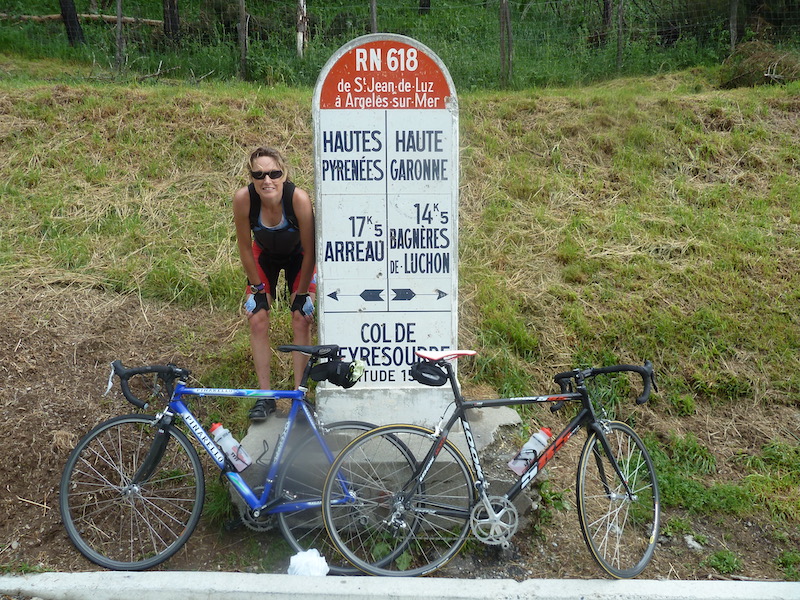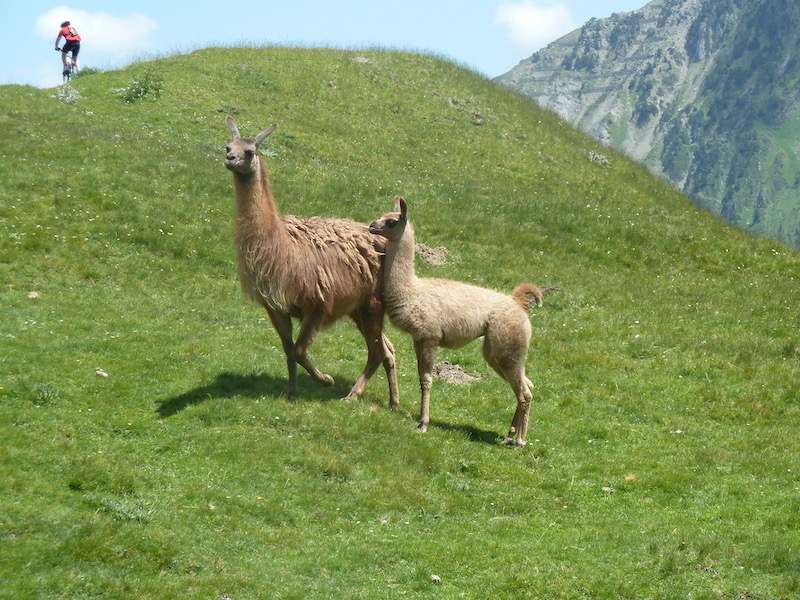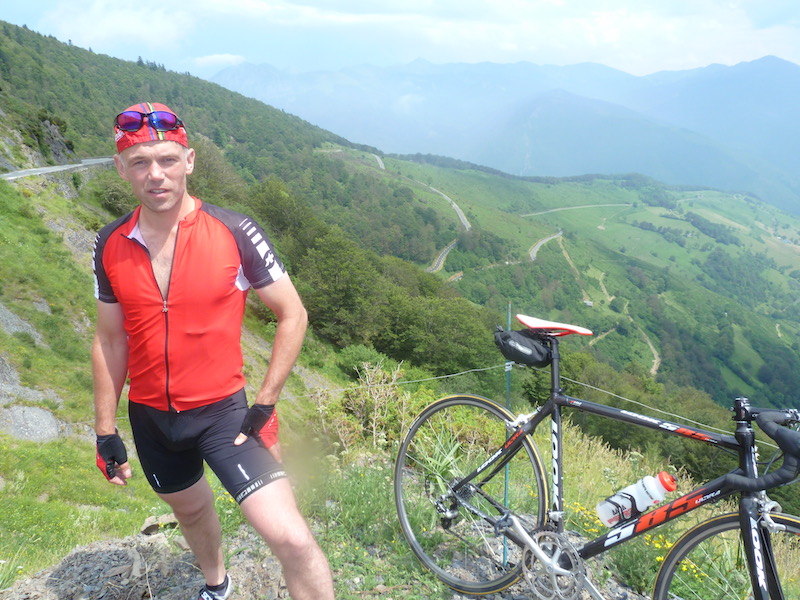The sheep give you respect. So do the llamas (yes llamas!). As do an enthusiastic French public. Even the drivers respect cyclists in the Pyrenees. Our recent cycling holiday in the south-west of France was so spirit-lifting that the G-Force and I want to move there the minute we’re free of domestic ties!
I’m not saying that it was all fun, however. Climbing some of the highest road passes in the Midi-Pyrenees region was frequently a mind-over-matter slog. But the challenges (and that included spending a week with a very sore undercarriage!) were far outweighed by the sheer wonder of this gorgeous place.
So, if you’re a keen cyclist, you’ll be wondering about our tally of cols! The numerous high cols of the Pyrenees have been made famous by the Tour de France. This year, the Tour celebrates the centenary of the event’s first venture into this region and so they are making a huge fuss about the cols. In fact, Stage 16 on July 20 will see the professional riders tackling four of these legendary road passes including Peyresourde (1569m), Aspin (1490m), Tourmalet (2115m) and Aubisque (1709m). Starting from Bagneres-De-Luchon the stage covers almost 200kms to finish in Pau.
Two days later, the Tour riders will leave Pau to cycle 174km and two more cols, Marie-Blanque (1035m) and Soulor (1474m), before finishing on the summit of Tourmalet, this time from the west side. It’s the first time in the history of the Tour that the same col is to be ridden twice.
Cycling the Tourmalet
Indeed, it’s the beast that is the Tourmalet that attracts many thousands of amateur cyclists to the Pyrenees every year. At 2115m (6939ft), the summit of the Col du Tourmalet is more than one-and-a-half times that of Britain’s tallest peak, Ben Nevis. Tackling the western side, from the village of Luz-Saint-Saveur means a muscle crunching 19km of climbing over 1404m at an average gradient of 7.4%. At several points the gradient tops 9%, and even 10%.
The east side of the Tourmalet is no friendlier (and most reckon it’s the harder climb). Starting from Sainte-Marie-de-Campan, the climb is 17.2km with a gain of 1268m but with a steeper average ascent over the last 12kms of about 9%.
While the distances might not seem like much, the non-stop ascent really does hurt. On the first day the G-Force and I “eased” ourselves into the holiday with a ride up the west side of the Tourmalet. It didn’t seem so bad to start with and at the first marker (there’s a marker sign every 1km to tell cyclists and drivers about the gradient over the next 1km, the altitude and the distance to the summit) with 18km to go I was making steady uphill progress and had three gears left to utilise. (I had taken on board the recommendations of various cyclist friends to add a couple of smaller gears to my racer bike.)
By 16km I’d dropped another gear. By 14km I only had one easier gear left. Then, not even halfway to the summit, I realised I was in the easiest gear and would just have to keep on going up very slowly indeed.
Highlights of Pyrenees cycling
Thankfully there were many highlights to keep me pushing the pedals around:
* The views of the mountains and huge waterfalls were more impressive than I can ever recall.
* The many other cyclists, some who passed me and some whom I overtook, were wonderfully friendly and encouraging.
* The G-Force who cycled with me – and egged me on – for as long as he could before settling into a faster pedal rhythm that better suited him.
* The sheep, who wander the mountains and roads and who, at one point, had the courtesy to stop mid-road to let me cycle pass.
* The llamas, who also wander the Tourmalet, and who provide one of the cutest sights you’ll see while cycling.
* The vultures who circle high above in the bright blue sky and provide a fascinating distraction.
However, in the final few kms of the Tourmalet I found I could think of little else but a need to “beat the beast”! At this stage the hairpin bends seemed to get tighter and the gradient became even steeper. I was shocked when two Belgium 70-year-olds who I thought I’d left behind an hour before came past me, pulling for breath at the altitude of 1850m but still steadily cycling onwards – and faster than me!
After this the only incentive I could find to reach the top was how embarrassing it would be to be forced to get off to walk. I wished that I had a lighter bike, stronger leg muscles, a masseur to take the pain from my back and shoulders, someone to wipe the sweat from my forehead, back and butt – and a large G&T.
Finally – the top of the Tourmalet
But finally, and with grit determination, I crept towards the summit. As each person pushed their way to the highest point there were cheers and clapping from other red-faced but grinning cyclists. Climbing off the bike on wobbly legs I welcomed a huge hug from the G-Force and then walked a slightly crazy path to the summit marker for a photograph that I will treasure for a long time to come. Looking back down at the long, snaking road up the Tourmalet I felt a huge amount of pride. I’d known all about these cols for years because of the Tour de France but I never imagined I’d ever cycle to the top of the grand-daddy of them all.
I never imagined that there could be so much downhill either! Speeding down the east side of the Tourmalet heading towards our hotel for the night in Bagneres de Bigorre felt like a fantasy on wheels. For kilometre after kilometre and up to speeds of 40mph we just kept on free-wheeling. Awesome is an understatement!
Over the next two days the G-Force and I pushed ourselves to explore as many cols as possible. When in Rome…! On the second day we again ascended the Tourmalet, this time from the east side – “just to see if it is tougher,” pleaded the G-Force. (On tired legs I thought it was harder than the west side, but the G-Force reckoned it suited him better) – and then went on to summit the Col D’Aspin, too.
Day three of tour of the Pyrenees
On the third day we climbed the Col D’Azet and the Col de Peyresourde. By the time we reached the summit of the last col I was truly done in, but the sense of achievement was amazing. On balance, three days of tough climbing was more than outweighted by the glorious sunshine, fabulous views, spirit-lifting descents and wonderfully companionable cycling.
And then came the flatter cycling days. We were being kindly hosted by the tourist boards in the area (including Midi-Pyrenees Tourist Board, Haute-Garonne Tourist Board, Hautes-Pyrénées Tourist Board, and ATOUT FRANCE). As well as organising a host of great hotels and restaurants, trains, flights, spas and a city cycle tour, various members of these tourist boards were also helping to transfer our baggage between accommodations. They were keen for us to experience both the mountains of the Pyrenees and some of the beautiful valley routes. (If you’re interested in a cycling tour holiday in the Pyrenees than a company to recommend would be Discover France.)
And so after all the col challenges we were treated to a day of cycling almost entirely downhill and on the most amazingly smooth, traffic-free cycle way called Parcours Cyclable De La Garonne. This mostly purpose-built route (ideal for road bikes) heads from Cierp-Gaud, about 20kms from Luchon, along the picturesque River Garonne and all the way to Carbonne. This track totals around 110km – and we rarely came across a car. While we managed the total mileage in one day, the route could easily be divided into shorter sections. There are a number of train stations along the way where less energetic cyclists or cycling families could jump on to head back to their start point. I have never before had the pleasure to ride such a fantastic cycle way.
Cycling from Toulouse
A train from Carbonne then took us, with our bikes, to the “Pink City” of Toulouse. It’s called the “Pink City” because so many of the buildings are made from a local clay that dries to a gorgeous hue of pink. A “rest” day included a two-hour cycle tour of the city. Thanks to our English-speaking guide we were shown some of the many architectural and historic highlights of this vibrant city. We were also very impressed with the respect that is given by drivers to cyclists. So used to vehicle dodging, as well as the driver danger and rudeness in Scotland it felt like we’d entered another world as cyclists were honoured with right of way. According to our guide, despite there being many thousands of cyclists in this oh-so-flat city there are very few accidents.
Our final day of cycling took us along another traffic-free cycle route. This time we headed via the Canal du Midi, south east from Toulouse. Some 50km of bank-side route offers easy-going cycling for all kinds of bikes and again we enjoyed both sunshine and lots of “flat”. It was only when we headed off the purpose-built trail at Port Laurgais to cycle via quiet country lanes to our hotel for the night in Revel that we again came across a few ascents. In comparison to the mighty mountains of previous days, these ascents amounted to mini molehills but still my legs didn’t feel much like pushing. I think my body was calling for a bit of rest and relaxation!
Revel at the heart of the Tour de France
Revel will be a major stage on the Tour de France this year. The town, which has already seen the Tour stop eight times since 1966, will feature as the end of stage 12 and the start of stage 13 in the 2010 tour. It’s clear that Revel and its people are very excited about this. Almost every shop window featured a Tour display and there were banners and flags announcing the forthcoming presence of the Tour everywhere we looked. The G-Force and I spent a lovely half-hour wandering around a special Tour de France photographic exhibition located in the central square.
Our post-cycling bodies also demanded that we consume delicious patisserie flans, strong coffee, beer and then a fabulous cassoulet and heavy duty red wine at our restaurant/hotel, the Hotel Restaurant du Midi.
I can’t tell you how unwilling we both were to leave the hotel for the airport the next morning. Worse still we had to endure a two-hour delay when all we could see outside were blue skies and all we could think about was more wonderfully scenic cycling. Now we’ll need to focus on our dream of our retirement in the French Pyrenees – and watching those muscle-bound Tour de France crazies as they race up the Pyrenean cols.
To put their ability into perspective: It took me 1hr 40mins to do the west side of the Tourmalet and 1hr 55 mins to complete the east side. In 2009, the main contenders for the Tour’s yellow jersey reached the summit of the Tourmalet from Campan in 54 mins. The fastest ascent for the 12.6km section from Gripp is claimed to be by Jan Ullrich, of Germany, in 2003 in a time of 38 mins 43 seconds.
Times for the western ascent have not been recorded in the Tour but this year it’s estimated the fastest will summit in 50 to 55 minutes. Awesome!
Travel notes if you fancy cycling in the Midi-Pyrenees
Getting there: Jet2 flies from Edinburgh to Toulouse. It is possible to book bikes on the flight as extra baggage. SNCF train network offers regular trains, with bike spaces, from Toulouse to Tarbes, as well as other prime locations for cycling in the Pyrenees.
We stayed at: Hotel les Cimes, in Argeles Gazost; Relais des Pyrenees – Centre Laurent Fignon, in Bagneres de Bigorre; Hotel d’Angleterre in Arreau ; Hotel de Paris in Luchon; Hotel Royal Wilson in Toulouse; and Hotel Restaurant du Midi in Revel.
Baggage transfer: It is possible to base yourself in one hotel or village and enjoy cycling routes each day. Or if you’re up for some heavy duty cycle touring you could carry your luggage on your bikes. But perhaps a better way to enjoy the route of the Tour is to join a guided holiday or to employ the services of a baggage transfer company. Discover France is a cycling tour operator based in Lunel and working in the Pyrenees.
Anything else to do?: Many of the towns and villages on our cycling adventures offered a wealth of sightseeing opportunities. I’d also recommend you check out the thermal spa centre Aquensis, at Bagneres de Bigorre. For jaw-dropping 360-degree views visit the astronomical observatory, Pic du Midi accessed via cable car from La Mongie on the Col du Tourmalet.



















